Expanding Consciousness
By Lars Chittka, Catherine Wilson
Bees and other insects show signs of possessing complex self-awareness, but if the scope of conscious beings widens, where will it end?
Bees and other insects show signs of possessing complex self-awareness, but if the scope of conscious beings widens, where will it end?

Consciousness is a state of awareness that allows us to close our eyes and picture our childhood home or perform the sort of planning, prediction, and risk assessment required to gauge whether it’s safe to jump over a stream of a given width. It allows us to solve problems by thinking rather than relying on trial and error.
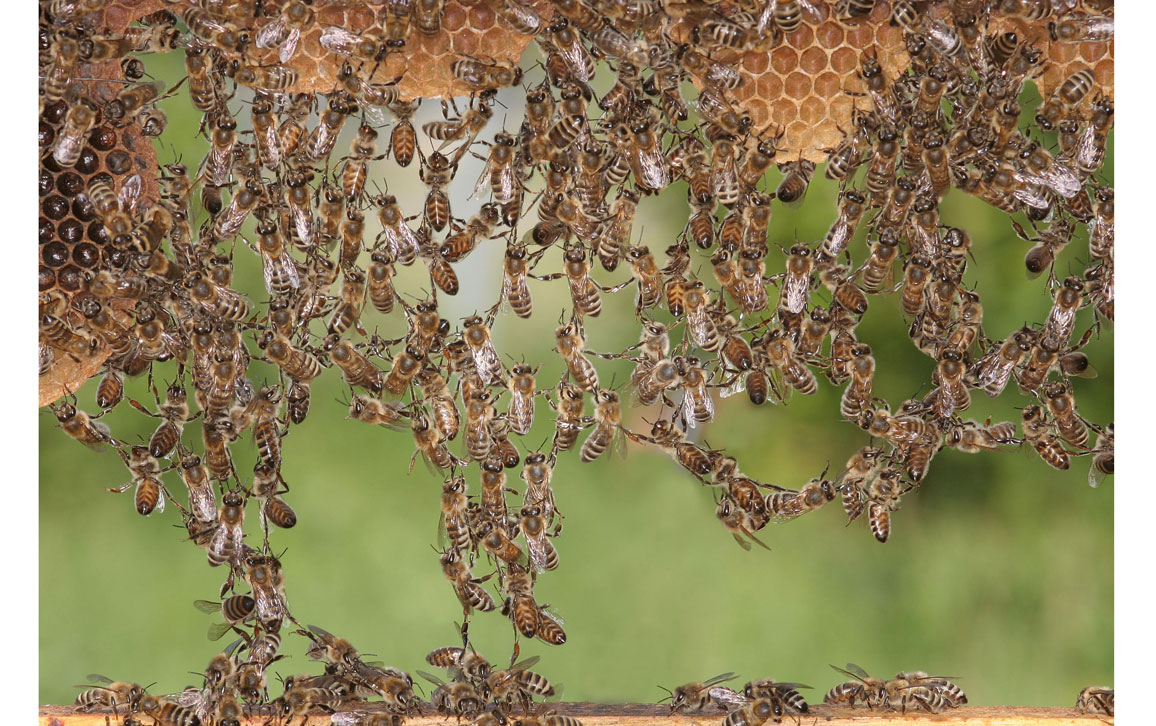
Helga Heilmann
For centuries, scholars such as René Descartes (1596–1650) have argued that consciousness is a uniquely human attribute, perhaps facilitated by language, that allows us to communicate about our memories and feelings, and coordinate plans for the future. In this view, nonhuman animals were regarded as merely cleverly designed automatons with a toolkit of preprogrammed behaviors, each triggered by certain environmental stimuli.
Social insects such as bees and ants seemed to epitomize this viewpoint. Scientists acknowledge that a large behavioral repertoire is required for such insects to construct their elaborate homes, defend them against intruders, and provision their young with adequate nutrition; however, until recently, prevailing theories held that these animals were “reflex machines” without internal representation of the world or an ability to foresee even the immediate future. In this view, insects were close to the notion of philosophical zombies—hypothetical robots that behave overtly like normal humans but are entirely based on preprogrammed behavior routines and reflexes, without any self-awareness.
Increasingly, however, scientists are taking note of the many indications that insects exhibit consciousness-like phenomena. Some lines of evidence are from experiments that have lain buried in the literature for decades, even centuries, without anyone recognizing their significance for consciousness.
Honeybees, for example, have a symbolic, movement-based language by which they communicate about the precise coordinates of floral food sources or potential nest sites (see “Group Decision Making in Honey Bee Swarms,” May–June 2006). In this dance language, a scout bee returning from a flower patch performs a repetitive sequence of movements in the dark hive on the vertical comb. These movements are keenly attended by other bees. The successful forager moves forward in a straight line for a few centimeters, then a half circle to the left back to her starting point. She performs another straight run, and then circles to the right. The duration of the straight run tells other bees the distance to the food source (roughly one second of walking distance in the dance corresponds to a one-kilometer flight to the target). The direction of this run relative to gravity encodes the direction relative to the Sun—for example, if the run in the hive is straight up, this tells other bees to fly in the direction of the Sun.
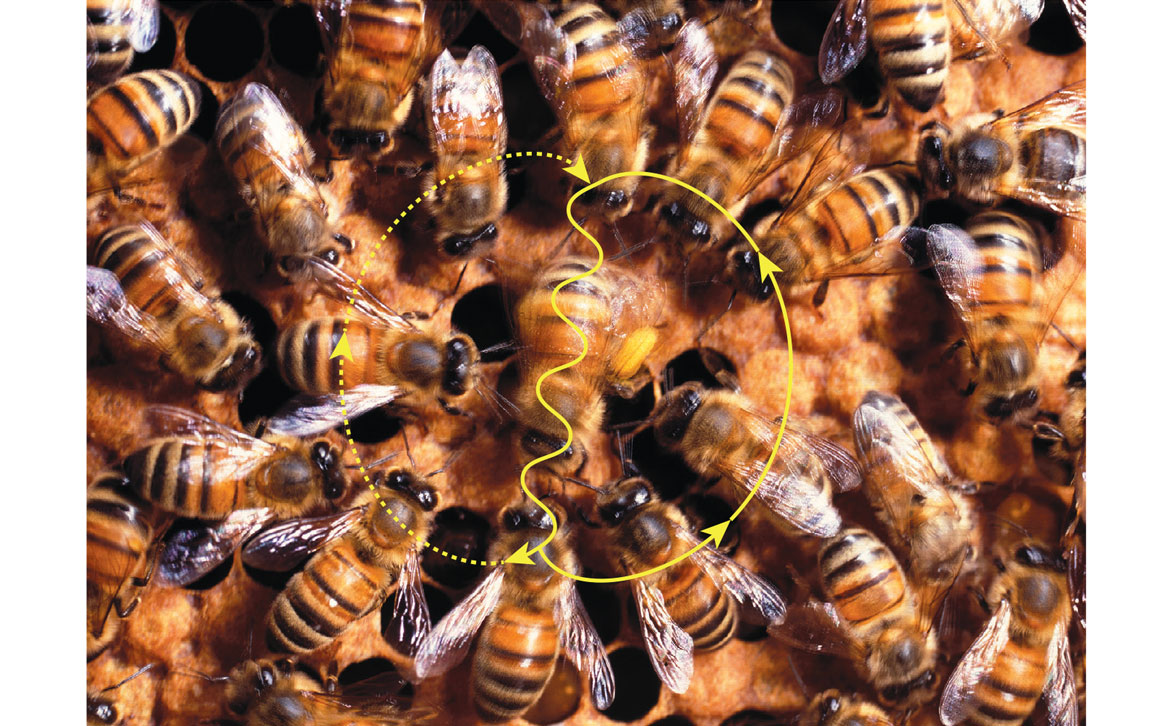
Warren Photographic
Karl von Frisch made this discovery in 1945, for which he was later awarded the Nobel Prize in Physiology or Medicine. A decade later, one of his students, Martin Lindauer, peered into a beehive and discovered that some bees continued these discussions into the night. Before midnight, they “talked” about locations visited the previous evening, and in the hours before sunrise, they communicated about locations visited the morning before.
These bees retrieved their spatial memories entirely out of context, at a time when there was no possibility of foraging and no need for communication. The function is unclear—they may have spontaneously thought about these spatial locations during the night, or perhaps this communication functioned as a strategy for spatial memory consolidation. Later studies have shown that a bee’s memories of the previous day become strengthened when the insects are exposed to elements of these memories while they are deeply asleep. Perhaps bees dream about the experiences of the previous day?
The key implication in Lindauer’s discovery is that bees are capable of offline thinking about spatial locations (and the ways in which the locations are linked to time) in the absence of any external trigger—a conclusion that does not align with the assumption that bees are zombies. Bees, then, appear to have at least some of the principal hallmarks of consciousness: representations of time and space.
Based on such evidence, many biologists and philosophers now suspect that consciousness-like phenomena might be evolutionarily ancient, perhaps dating back to the Cambrian Period (approximately 500 million years ago). This line of inquiry might seem like a slippery slope. Where should we draw the line? Do plants have some form of awareness? Or, as panpsychists believe, do electrons, rocks, computers, or the universe have anything of the sort? If so, we are at risk of expanding the definition of consciousness to include ever more living and nonliving beings until the term becomes meaningless.
Solid proof of consciousness in anyone except oneself is of course unattainable. Everyone else may be a machine or a zombie. But then again—say some philosophers—we may be just brains in vats.
One elementary phenomenon at the heart of biological consciousness is self-recognition: the ability to recognize oneself as distinct from another entity, as well as to plan, pay attention, recall memories of specific events, and take the perspective of another creature. If the image on your retina suddenly tilts by 45 degrees, you know that this is fine if it’s the result of deliberately inclining your head—if not, you may be witnessing a major seismic event.
Animals, including humans, are thought to tell the difference between these scenarios via what’s known as an efference copy: an internal signal that communicates the consequences of the animal’s own actions, so that it can distinguish sensory changes caused by its movements from changes caused by external forces. Under normal conditions, animals expect the environment to move in a predictable manner when they turn their heads voluntarily. This expectation allows them to anticipate what will happen next, as a result of their own actions or intentions.
Early versions of efference copies were proposed in the 19th century, although the term was coined by the German biologists Erich von Holst and Horst Mittelstaedt in their study of flies. In one of their experiments in 1950, they inverted the input to the fly’s brain from the left and right eyes using a rather crude (and cruel) technique: The thin neck of the fly was twisted by 180 degrees, and its head then glued in place upside down. The result was that, when the animal turned left or right, the sensory signals were the opposite of those it expected. Deprived of its ability to anticipate what it should see as a result of its own intentions, the fly behaved erratically. Insects with their heads in the normal position appear to have another of the key ingredients of consciousness: the ability to predict what will happen in the future as a result of self-generated movements, which allows them to move and act effectively.
At its evolutionary roots, we believe that consciousness is an adaptation that helped solve the problem of how moving organisms extract meaningful information from their sense organs. In an ever-changing and only semipredictable environment, consciousness can solve this problem more efficiently than unconscious mechanisms possibly could. As zoologist Donald Griffin wrote in his book Animal Minds (1992), “Environmental conditions vary so much that for an animal’s brain to have programmed specifications for optimal behavior in all situations would require an impossibly lengthy instruction book.”

Vincent Gallo
Bees provide further evidence that insects can cope with unusual challenges that no instruction book could anticipate. More than 200 years ago, the Swiss entomologist François Huber (1750–1831) suggested that honeybees might display foresight in the construction of their honeycomb. Working with his wife Marie-Aimée Lullin and servant François Burnens, Huber placed glass panes into the path of honeybees building a hive. Glass is a suboptimal surface to which to attach wax, so the bees took corrective action long before they reached the slippery surface: They shifted the structure’s orientation 90 degrees to attach the comb instead to the nearest wooden surface. The bees had extrapolated from the direction of their current construction to the target zone and anticipated a suboptimal result before it occurred.
On another occasion, Huber’s team created an environment where the bees had no choice but to build their hive on a glass surface. The researchers observed that one of several combs broke off the ceiling of a hive during winter. Hive construction normally pauses during winter months when bees minimize their activity to preserve their stores until spring. On this occasion, however, not only did the bees become active to fortify the dislodged comb with a number of pillars and crossbeams made from wax, but they also reinforced the attachment zones of all the other combs on the glass ceiling, apparently to ensure that the problem would not recur. Such foresight, should it be confirmed experimentally with modern methods and sample sizes, is one of the hallmarks of consciousness and, in this case, already extends beyond predicting just the immediate future.
One of us was part of a 2017 study of tool use among bumblebees where the insects were required to transport a small ball to a defined location in order to receive a sugar reward. Observer bees learned how to solve the task through social demonstration by skilled bees. When later tested on their own, the observer bees improved on the technique of the demonstrators, choosing a ball closer to the designated location. They did this even when the closest ball was colored black instead of the trained yellow. Rolling a ball is not a behavior that bees perform in nature. The observers had no prior experience with rolling the balls themselves and thus had no opportunity for trial-and-error learning. These results indicate that instead of “aping” a learned technique, bumblebees spontaneously improved on the strategy used by the demonstrators, suggesting they appreciated the outcome of their actions.
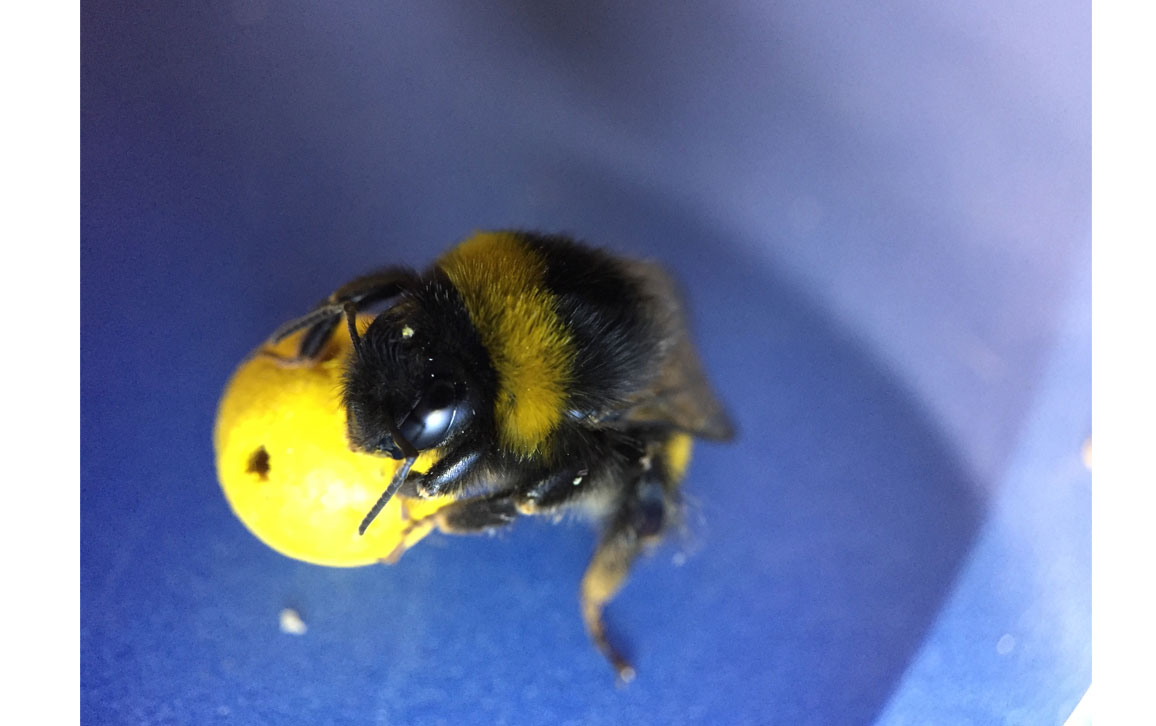
Iida Loukola
Can bees not only plan, but imagine? They can certainly learn to associate visual patterns (such as those presented on flowers) with nectar rewards, but this recognition does not necessarily imply that they have an image of such flowers floating around in their heads. In fact, neural network analyses show that even complex visual patterns (that consist, for example, of differently oriented stripes in all four quadrants of the pattern) can be recognized with just two simple feature detectors that sample information across the visual field—without the need to store the actual image in the bee’s memory.
But a 2018 experiment in which one of us participated indicates that bees might indeed be able to picture the spatial arrangements of features in a pattern. In this experiment, bees were first trained to distinguish two types of artificial flowers that were visually identical, but which had ”invisible patterns” made up of small scented holes that were arranged either in a circle or in a cross. The bees were able to figure out these patterns by using their feelers. But the most exciting finding was that, if these patterns were suddenly made visible by the experimenter (so that the flowers now displayed visual circles or crosses), bees instantly recognized the image that formerly had been just an ephemeral pattern in the air. This finding suggests that the bees might indeed have a mental representation of the shape, rather than relying on simple feature detectors in their visual system to recognize patterns.
Bees also display optimistic and pessimistic emotional states, at least when their behavior is evaluated using the same criteria by which domestic animals are commonly assessed. In such tests, bees first learned that one stimulus (such as the color blue) is linked to a sugar reward, while another (such as green) is not. They were then faced with an intermediate stimulus (in this example, turquoise). Fascinatingly, they responded to this ambiguous stimulus in a “glass half full” (optimistic) manner, if they had encountered a surprise reward (a tiny droplet of sucrose solution) on the way to the experiment. If an adverse stimulus was unexpectedly experienced, they responded in a “glass half empty” (pessimistic) manner.
Further evidence that qualitative experience is available to a range of animals is furnished by consideration of mind- or mood-altering drugs. Not only mammals (think of the effects of catnip) but also some insects indulge in them. Volatile anesthetics, appetite-suppressing stimulants, depressants, and hallucinogens are naturally produced by plants and fungi. These chemicals are accidental byproducts of their biomolecular machinery but also defense in deterring herbivores. But they do not always deter: Bees, for example, prefer flowers whose nectar is laced with low levels of nicotine.
Alcohol is widely present in nature in the form of fermented fruits. Molecular biologist Galit Shohat-Ophir, of Bar-Ilan University in Israel, and her colleagues discovered that fruit flies stressed by being deprived of mating opportunities seek out alcohol. This activity suggests that intentional sensation adjustment or even mood adjustment, as well as involuntary susceptibility to psychotropics, is widespread across the animal kingdom—which strongly implies that animals have inner experiences. It will be important to rule out alternative explanations, in which behavior is modified via direct effects on neurotransmission or the digestive system, but it is nonetheless a promising avenue for future research. Why would an organism seek out mind-altering substances when there isn’t a mind to alter?
One objection to the hypothesis of insect consciousness is that their brains are simply too small. But at the time of writing, the much sought-after neural correlate of consciousness (NCC) has not been identified in humans; thus one cannot argue that certain animals don’t have human-type NCC. What we can say is that insect nervous systems are anything but simple: Although a bee brain has only about 1 million nerve cells (compared to approximately 80 billion in a human brain), some individual neurons have a complexity of branching that rivals a fully grown oak tree. A bee brain may have about 1 billion synapses (connections between neural wires that can be shaped by experience).
Bees spontaneously improved on the strategy used by the demonstrator, suggesting they had an appreciation of the outcome of their actions.
In addition to their intricacy, insect brains also have other physiological properties required for consciousness. If they operated solely by reflex, the flow of information would be expected to go from the sense organs to the mechanisms responsible for motor control. But in insects, there are many top-down processes at work, in which neural cables send messages from the central brain to the sensory periphery.
Such top-down processes are involved in attention-like phenomena. Attention allows animals to focus specifically on important stimuli (such as a flower known to have plentiful nectar, if you’re a bee) and disregard others (flowers with less nectar). The neuroscientist Bruno van Swinderen at the University of Queensland in Australia has discovered specific neural signatures of attentive states in insects. He also found evidence that a bee knows what visual stimuli to expect next, thereby demonstrating that its neural activity is not simply generated as a result of stimuli “trickling down” from the sense organs to the central brain. Any activity generated from “within the brain” (meaning in the absence of external stimulation) is of particular interest in the context of consciousness.
Van Swinderen also discovered that flies’ brains have several types of neural signal oscillations, including when they are asleep. As in humans, where different oscillations accompany deep sleep and REM sleep, flies have different patterns of oscillations in various sleep phases. The insect brain is never ”switched off”— thus there may be dreamlike states in both flies and bees.
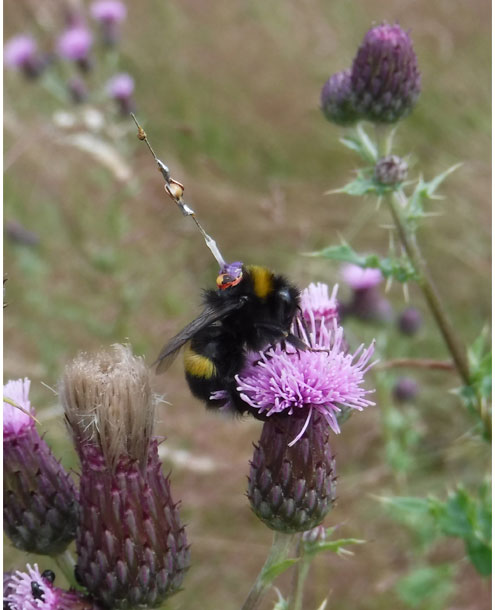
Lars Chittka
Neuroscientists Tzvetan Popov and Paul Szyszka from the University of Konstanz in Germany recently discovered that honeybees have the kinds of neural oscillations synchronized across the brain that, at least in humans, are associated with conscious states. Although neural oscillations alone do not create consciousness, it is widely agreed that certain types of such oscillations are a key ingredient of conscious states. And nervous systems would have generated some form of oscillations right from the start of animal evolution, because they are key to the rhythmic muscle contractions that form the basis of locomotion. During later evolutionary elaboration of nervous systems, brains might have co-opted such preexisting neural pacemakers to generate spontaneous activity from within the brain, ultimately leading to phenomena such as conscious thought.
Humans and flies seem to have little in common, but they both possess heads, abdomens, legs, and sensory organs. Biologist Lewis Held at Texas Tech University theorizes that these similarities are due to a deep homology, meaning that both species inherited the genetic predisposition to produce such features from a common ancestor. Even though that ancestor was a likely a legless worm, it passed on the potential for these developments. This theory applies to the brain as well.
The anatomical and functional parallels between the central complex of the insect brain and the basal ganglia of vertebrates are striking and point to a common genetic origin. Defects in both these systems produce motor problems, impaired memory, attention deficits, emotional disorders, and sleep disturbance. According to biologist Andrew Barron of Macquarie University in Australia and philosopher Colin Klein of the Australian National University, the central complex is a likely contender for mediating subjective experience in insects.
What about the possibility of consciousness in even simpler animals, and indeed beyond animals? In the mid-19th century, Charles Darwin wrote about not only the moral and emotional feelings of animals but also their appreciation of beauty and the recruitment of that susceptibility in sexual selection. He speculated that because Planaria (flatworms) have a central nervous system, they must have some form of consciousness. In The Power of Movement in Plants (1880), he went on to compare the animal brain and the plant’s root radicle, or taproot. This taproot must find its way, by some form of sampling and evaluation, to the best sources of anchorage and nourishment.
Although this proposal has been taken up recently by František Baluška at the University of Bonn in Germany, and by Anthony Trewavas at the University of Edinburgh, the case for plant consciousness is more difficult to make than the one for insect consciousness. Trewavas argues that parts of plants move to approach an object or to avoid an obstacle, and their stems can probe, twine, or lean, but their movement timescale is so slow that we may be simply overlooking the rudiments of intentionality in their behavior. However, plants do not move their bodies as a unit, and therefore don’t need (or have) a central nervous system enabling the whole body to navigate in space. And as we’ve argued above, we believe that a central nervous system is critical for the first stages of development of a conscious distinction between self and world.
Another objection needs to be addressed before one credits too many organisms with consciousness. Much of human behavior depends on subconscious processing. Our actions in the world depend to a surprising extent on stimuli we haven’t consciously noticed, and the experience of volition has been found to follow our actions after a time-lag rather than preceding them or being simultaneous with them. One could interpret this gap between many human actions and conscious thought as evidence that consciousness has no causal input into behavior. According to this theory, the brain collects and weighs environmental stimuli and data from memory, computes the best option, and makes the behavioral choice for us by initiating an action. If consciousness is causally ineffective, the argument that animals need it for living is unavailable. Or perhaps what we need consciousness for is fully automated in them.
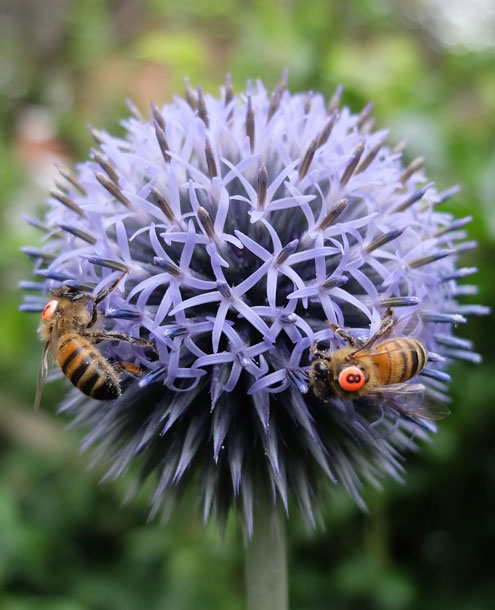
Lars Chittka
These arguments, however, do not diminish the case for widespread consciousness in the animal kingdom. It is obvious that—despite the wonders of unconscious processing—human beings cannot nourish themselves, escape predation, reproduce, engage in social lives, or find the way to a new destination without consciousness of a world outside the body.
What about the panpsychist notion that the universe, computers, electrons, and other lifeless beings might possess consciousness? We hold that because these entities do not face decisions requiring agency, it would be astonishing if they had experiences. The challenges that come with survival and self-replication faced by a moving, living organism are most efficiently implemented through emotions, a rich representation of the world, and the ability to anticipate at least the immediate future.
It might seem like prejudice to tie consciousness to life. Increased computing power and machine learning have enabled the automation of pattern recognition, including the recognition of faces and human speech, the simulation of meaningful conversation, automated theorem-proving in logic and mathematics, and even the creation of fine art (see “AI Is Blurring the Definition of Artist,” January–February 2019). As artificial devices acquire more and more of these competencies, why shouldn’t there come a moment when they wake up into consciousness? (See "Intelligence May Not Be Computable.")
But why should they wake up? We have no reason to think that consciousness must appear when automated performance of activities that are significant to humans, such as chess playing, reaches a high point of development. The more likely outcome is that we are unable to produce a fully competent living robot unless and until we can discover, and replicate synthetically, the elusive NCCs.
If we could generate self-repairing, self-replicating robots with evolvable software and let them roam freely under competitive conditions, would the most successful ones ultimately be those with subjective experiences, emotions, the ability to predict the results of their behaviors, and relatively flexible problem-solving skills? Or would conventional robots with a versatile toolkit of highly efficient but preconfigured, hard-wired responses fare better?
If, as we have argued, consciousness is an evolutionary invention—akin to wings or lungs—that is useful to us, it is most likely useful to other organisms with traits deeply homologous to ours. They share with us the difficulties of moving, probing the environment, remembering, predicting the future, and coping with unforeseen challenges. If the same behavioral and cognitive criteria are applied as to much larger-brained vertebrates, then some insects qualify as conscious agents, with no less certainty than dogs or cats.
Chittka and Wilson met when both were fellows of the Wissenschaftskolleg zu Berlin (Berlin Institute of Advanced Study), and their discussions laid the foundations for the thoughts presented here. This article is an adapted from an essay previously published in Aeon.
Click "American Scientist" to access home page
American Scientist Comments and Discussion
To discuss our articles or comment on them, please share them and tag American Scientist on social media platforms. Here are links to our profiles on Twitter, Facebook, and LinkedIn.
If we re-share your post, we will moderate comments/discussion following our comments policy.